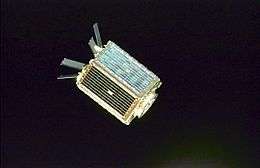MightySat-1
MightSat-1 was a small spacecraft developed by the U.S. Air Force's Phillips Laboratory (now part of the Air Force Research Laboratory Space Vehicles Directorate) to test technology for small satellites, including advanced dual-junction solar cells, a composite structure, a micrometeorite and debris detector, low-power electronics and a low-shock release device.[2] The 140-pound satellite was launched from the Space Shuttle Endeavour in December 1998, during the 12th day of the STS-88 mission[2] and performed robustly in orbit, with no spacecraft anomalies during its mission. Lt. Barbara Braun of the AFRL was the program manager for the satellite.[2]
MightySat-1's mission ended when it re-entered the atmosphere at 17:11 UTC on November 21, 1999.[3]
References
|
|---|
|
| Launch/orbital vehicles | |
|---|
|
| University Nanosat Program | |
|---|
|
| Space weather satellites | |
|---|
|
| Technology demonstrators | |
|---|
|
| Tactical Satellite Program satellites | |
|---|
|
|---|
|
Lunar Prospector | Skynet 4D | Ofek-4 | STS-89 | Soyuz TM-27 | USA-137 | Brasilsat B3 · Inmarsat-3 F5 | Orbcomm FM3 · Orbcomm FM4 · GFO · Ad Astra | Globalstar 1 · Globalstar 2 · Globalstar 3 · Globalstar 4 | Kosmos 2349 | Iridium 50 · Iridium 52 · Iridium 53 · Iridium 54 · Iridium 56 | Kakehashi | SNOE · Teledesic 1 | Hot Bird 4 | Intelsat 806 | Progress M-38 (VDU-2) | USA-138 | SPOT 4 | Iridium 51 · Iridium 61 | Iridium 55 · Iridium 57 · Iridium 58 · Iridium 59 · Iridium 60 | TRACE | Iridium 62 · Iridium 63 · Iridium 64 · Iridium 65 · Iridium 66 · Iridium 67 · Iridium 68 | STS-90 | Globalstar 6 · Globalstar 8 · Globalstar 14 · Globalstar 15 | Nilesat 101 · BSat-1B | Kosmos 2350 | Iridium 69 · Iridium 71 | Kosmos 2351 | EchoStar IV | USA-139 | NOAA-15 | Progress M-39 | Iridium 70 · Iridium 72 · Iridium 73 · Iridium 74 · Iridium 75 | Zhongwei 1 | STS-91 | Thor 3 | Kosmos 2352 · Kosmos 2353 · Kosmos 2354 · Kosmos 2355 · Kosmos 2356 · Kosmos 2357 | Intelsat 805 | Kosmos 2358 | Kosmos 2359 | Molniya 3-49 | Nozomi | Shtil-1 · Tubsat-N · Tubsat-N1 | Resurs-O1 #4 · Fasat-Bravo · TMSAT · Gurwin Techsat 1B · WESTPAC · SAFIR-2 | Sinosat-1 | Kosmos 2360 | Orbcomm FM13 · Orbcomm FM14 · Orbcomm FM15 · Orbcomm FM16 · Orbcomm FM17 · Orbcomm FM18 · Orbcomm FM19 · Orbcomm FM20 | Mercury 3 | Soyuz TM-28 | Iridium 3 · Iridium 76 | ST-1 | Galaxy 10 | Astra 2A | Kwangmyŏngsŏng-1 | Iridium 77 · Iridium 79 · Iridium 80 · Iridium 81 · Iridium 82 | Globalstar 5 · Globalstar 7 · Globalstar 9 · Globalstar 10 · Globalstar 11 · Globalstar 12 · Globalstar 13 · Globalstar 16 · Globalstar 17 · Globalstar 18 · Globalstar 20 · Globalstar 21 | PAS-7 | Orbcomm FM21 · Orbcomm FM22 · Orbcomm FM23 · Orbcomm FM24 · Orbcomm FM25 · Orbcomm FM26 · Orbcomm FM27 · Orbcomm FM28 | Molniya-1T #99 | STEX (USA-141) | Eutelsat W2 · Sirius 3 | Hot Bird 5 | USA-140 | Maqsat 3 | Deep Space 1 · SEDSAT-1 | Progress M-40 ( Sputnik 41) | AfriStar · GE-5 | STS-95 (SPARTAN-201 · PANSAT) | PAS-8 | Iridium 2 · Iridium 83 · Iridium 84 · Iridium 85 · Iridium 86 | Zarya / ISS | Bonum 1 | STS-88 ( Unity · PMA-1 · PMA-2 · SAC-A · MightySat-1 | Satmex 5 | SWAS | Nadezhda 5 · Astrid 2 | Mars Climate Orbiter | Iridium 11 · Iridium 20 | PAS-6B | Kosmos 2361 | Kosmos 2362 · Kosmos 2363 · Kosmos 2364 |
|
Payloads are separated by bullets ( · ), launches by pipes ( | ). Manned flights are indicated in bold text. Uncatalogued launch failures are listed in italics. Payloads deployed from other spacecraft are denoted in brackets. |
